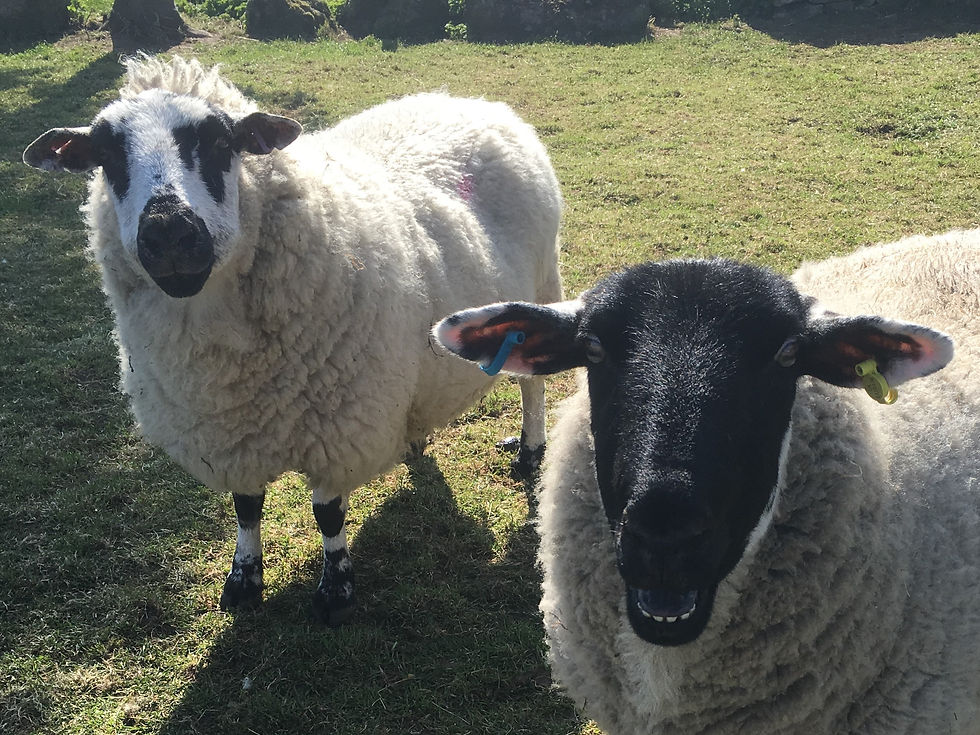About Our Flock
- Andy
- May 29, 2019
- 3 min read
Updated: May 30, 2019
The whys and wherefores of our Derbyshire Gritstone flock - where we got them, how long we've had them and why we - really - like them.

Why Derbyshire Gritstones?
Simply, because they were the only breed with a direct attachment to the Peak District where we live; because they are hardy, tough hill sheep (we are at 1000 feet); and because the fleeces take dye very well and are reputedly very versatile - historically used in everything from hosiery to fine knitwear to carpets - all of which would help when deciding what to do with the wool.
Gritstones are also really good looking with solid proportions, black and white faces and thick, fluffy fleeces which range from pale grey to bright cream.
And let’s not forget the characteristic, cute black spots on their front knees !
From a business point of view it would make more sense to start with the most saleable fibre and work backwards. From a creative point of view it is more exciting to see where the fleece leads us.
So far we are absolutely delighted with our hand knitting wool as processed by The Natural Fibre Company in Cornwall. In its undyed, natural state it has a fabulous depth of colour, almost luminous.

A Quick History of Derbyshire Gritstones
Gritstones originated in the Goyt Valley near Buxton in the late 18th century making it among the oldest hill sheep breeds in the UK. They were bred to be hardy, disease resistant and capable of withstanding harsh weather on poor ground, all while producing lively lambs and good wool.
Interestingly the Goyt Valley is only a couple of miles from where our yarn is now on sale at Wiseheart Studio in Whaley Bridge.
Although by no means completely unknown in the Peak District these days, over the years flocks have migrated north to around the Pennines.
The centre of operations is now Clitheroe in Lancashire where the Derbyshire Gritstone Sheepbreeder Society holds its annual show (though Gritstones are always out in force at the Bakewell Market hill sheep sale, traditionally held a few weeks earlier in October).
Gritstones are not just the oldest hill breed but among the largest sheep full stop: a mature ewe weighs up to 75kg (around 12 stone) while rams can top 100kg. The lack of horns, or wool on the head or legs, makes them easier to shear than they might be otherwise.

Almost three years of Derbyshire Gritstones
We bought our sheep from a very reputable breeder, high up in the breed society (we don’t want to splay his name all over the internet but if you want to buy some Gritstones we would be happy to put you in touch via our contact page).
Our Gritstones are pure breeds but not top flight competition winners. We were introduced to our breeder at the Clitheroe sale in October 2016. Some weeks later he phoned to say he had some 4 year old ewes that he hadn’t shown but that might be suitable for us.
The thinking was that mature ewes would continue to do well on our lush, lower ground compared to the exposed moorland of Yorkshire’s Nidderdale where they started life.
So on 31 October 2016 we took delivery of eight ewes, and a year later four more plus a ram, all from the same farm.
Bar one ewe which we unfortunately lost during lambing last year, the flock now is the same as it was then. So far we are glad to say Derbyshire Gritstones are living up to their billing as tough and hardy.
The flock has free range over our large field, in view of the house (unless they hide in the dip about half way down). They probably have too much land actually - they do tend towards fat - so we are looking to buy a few more this year.
All being well, the aim is for our sheep to live out their natural lives with us in exchange for a thick, creamy fleece each year, and hopefully a few lambs too.

Do you have any more questions? Please ask in the comments below.




Comments